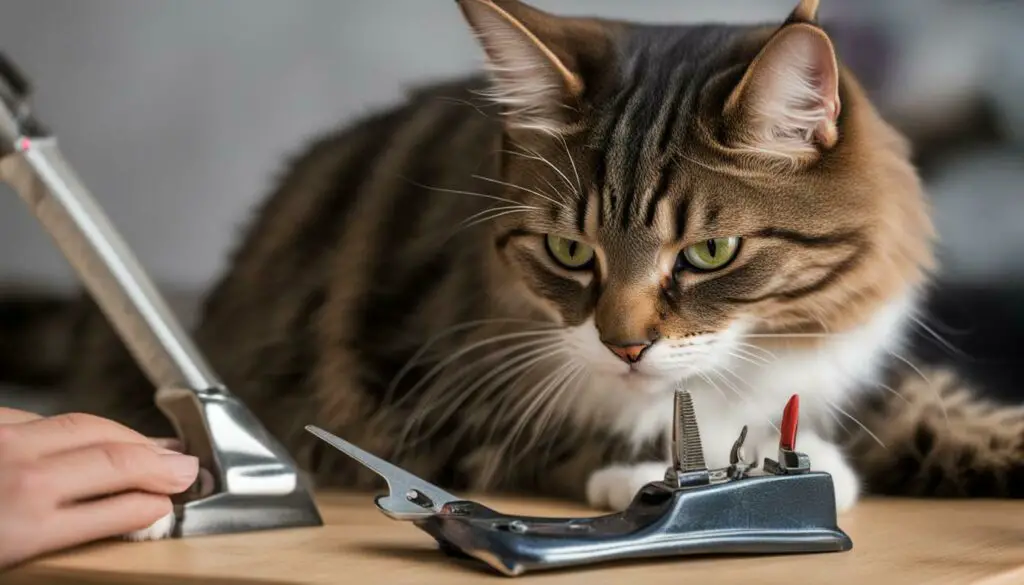Trimming a cat’s nails can be a daunting task, especially when your furry friend won’t let you near their paws. However, it is vital for their health and to prevent damage to your furniture and carpets. Cats’ nails grow quickly, and if left untrimmed, they can cause pain and infection by puncturing the pads of their paws. But don’t worry, I’m here to provide expert advice and tips on how to successfully trim your cat’s nails at home.
Key Takeaways:
- Starting nail trimming when the cat is young helps them get used to having their paws handled.
- Using the correct equipment, such as cat nail trimmers, is essential for a safe and precise trim.
- Be careful not to trim too far back or cut into the quick, where the blood vessels and nerves are located.
- If your cat is resistant to nail trimming, strategies like getting assistance, using the “kitty burrito” technique, or trimming one or two nails at a time can help.
- Declawing should never be attempted, as it is a harmful procedure with potential physical and psychological consequences for your cat.
By following these expert tips and techniques, you can ensure that nail trimming becomes a stress-free and positive experience for both you and your beloved feline companion. Let’s dive in and discover how to conquer those challenging nail trims!
The Importance of Cat Nail Care
Keeping your cat’s nails well-maintained is a crucial part of their overall care and can help prevent a range of issues. Cat nail care is important not only for the cat’s comfort but also for the safety of your furniture and carpets. Cats’ nails grow quickly, and if they are not trimmed regularly, they can become long and sharp, posing a risk of injury to the cat itself or their human companions.
Long nails can puncture the pads of a cat’s paws, causing pain, discomfort, and even infection. Trimming your cat’s nails regularly helps prevent these problems and keeps their paws healthy. Additionally, scratched furniture and ripped carpets can be a common occurrence if a cat’s nails are not kept in check.
To ensure proper nail care, it’s essential to start when your cat is young and get them accustomed to having their paws handled. This will help them become more comfortable with the nail trimming process as they grow. Using the correct equipment is also crucial. Investing in a good pair of cat nail trimmers can make the task easier and safer. Remember to be cautious and avoid trimming too far back, as this can cause bleeding or pain for your cat.
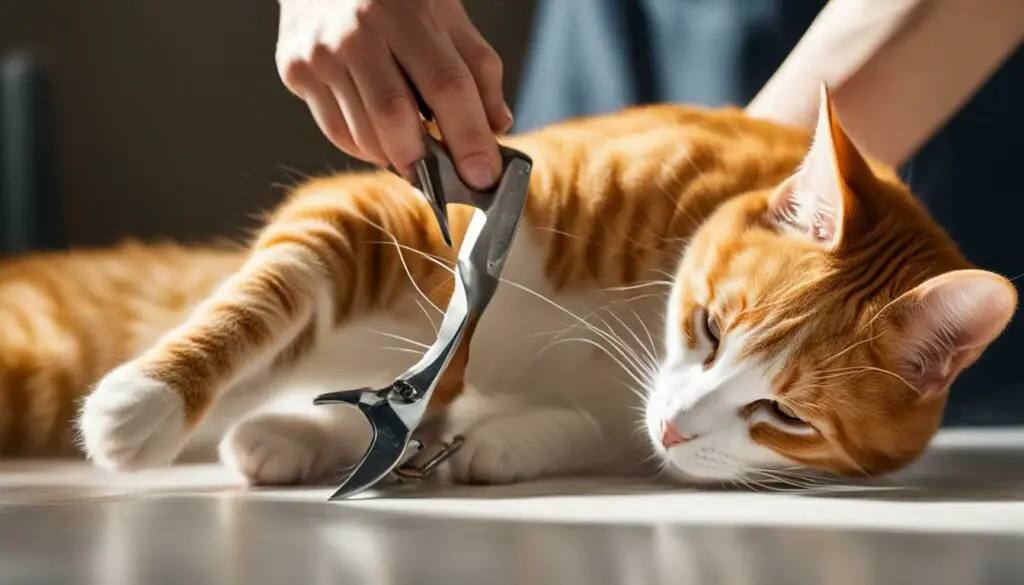
There are various techniques that can be employed to make nail trimming more manageable for both you and your cat. If your cat is resistant to nail trimming, consider enlisting the help of a family member or friend to hold the cat securely while you trim their nails. Another technique is to wrap your cat in a towel, creating a “kitty burrito,” which helps provide a sense of security and minimizes movement. Alternatively, you can try trimming one or two nails at a time, taking a staggered approach until your cat becomes more comfortable with the process.
However, if you find that you are unable to trim your cat’s nails yourself, don’t hesitate to seek professional help. A veterinarian or professional groomer can safely trim your cat’s nails for a fee. It’s important to remember that declawing should never be attempted, as it is a harmful procedure that can have long-lasting physical and psychological effects on your cat.
Understanding Your Cat’s Resistance
It’s important to understand why your cat may resist nail trimming to find the best approach to address their concerns. Cats are known for their independent nature and can be sensitive when it comes to having their paws touched. They may feel scared, threatened, or simply uncomfortable with the sensation. As a result, they may exhibit resistance during the nail trimming process.
One way to ease your cat’s resistance is by gradually introducing them to the idea of having their paws handled. Start by gently touching their paws while providing positive reinforcement, such as treats or praise. This helps create a positive association and builds trust between you and your furry friend.
Another technique that can help minimize stress is the use of distraction. Engaging your cat with playtime or treats before attempting to trim their nails can redirect their focus and make them more receptive to the process. Additionally, you can try providing a comfortable and secure environment by trimming their nails in a quiet, well-lit room where they feel safe.

Remember, every cat is unique, and what works for one may not work for another. Patience and a gentle approach are key when dealing with a resistant cat. If you’re unsure or uncomfortable with trimming your cat’s nails yourself, it’s always advisable to seek professional help from a veterinarian or groomer who has experience in handling difficult cats. They can offer guidance and ensure the process is done safely and stress-free.
Expert Tip:
“Understanding your cat’s body language is crucial when trimming their nails. Look out for signs of discomfort or stress, such as dilated pupils, flattened ears, or a swishing tail. If you notice these signals, it’s best to take a break and try again later.”
Getting Started: Early Introduction to Nail Trimming
The key to successful nail trimming is to introduce the process early and gradually to your feline friend. Start by gently handling your cat’s paws and getting them accustomed to the sensation. Use positive reinforcement, such as treats or praise, to create a positive association with paw handling. This will help your cat feel more comfortable when you eventually start trimming their nails.
When it’s time to start trimming, make sure you have the right tools on hand, such as cat nail trimmers. These are specifically designed to safely and accurately trim a cat’s nails. Remember to choose trimmers that are appropriate for your cat’s size and nail length.

Here’s a step-by-step guide to trimming your cat’s nails:
- Find a quiet and calm environment where your cat feels relaxed.
- Hold your cat gently but securely, making sure they are comfortable and supported.
- Take a close look at the nails and identify the translucent area called the quick. Be careful not to cut into the quick, as it can cause bleeding and pain.
- Trim the nails one at a time, taking small, cautious cuts off the tip of each nail. Aim to create a slight curve, similar to the shape of a cat’s paw.
- If your cat becomes stressed or anxious during the process, take a break and try again later. It’s important to prioritize your cat’s comfort and well-being.
Remember, patience and gradual introduction are key when it comes to trimming your cat’s nails. With time, practice, and positive reinforcement, you can create a stress-free nail trimming routine that benefits both you and your feline friend.
Essential Equipment for Cat Nail Trimming
Investing in the right tools for cat nail trimming can make all the difference in the process. Using the correct cat nail trimmers is essential to ensure a safe and precise trim. There are different types of nail trimmers available, including guillotine-style trimmers, scissor-style trimmers, and grinder-style trimmers. Each has its own advantages, so it’s important to choose the one that you and your cat are most comfortable with.
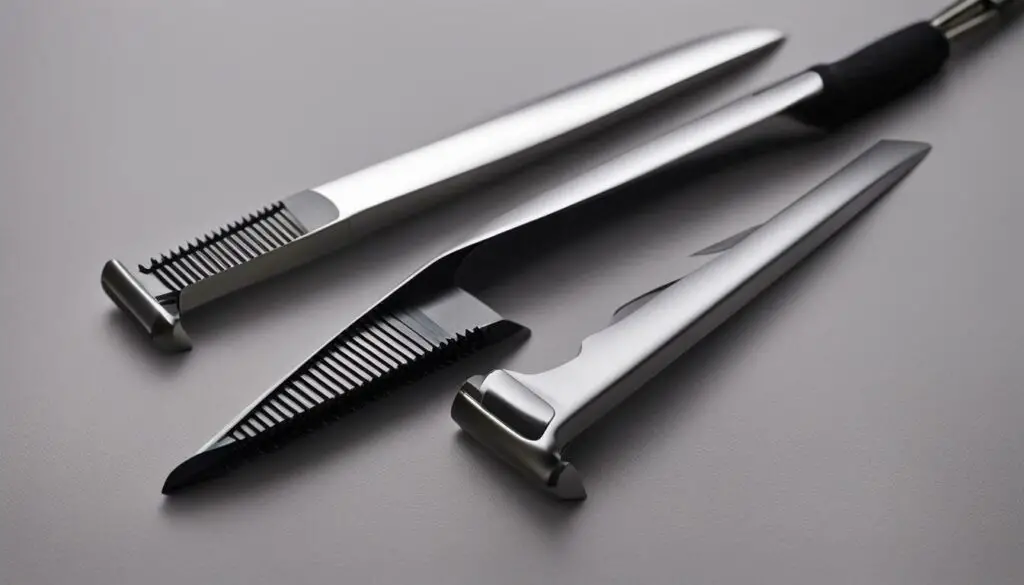
Guillotine-style trimmers have a hole where you insert the cat’s nail, and a blade that slices off the tip when you squeeze the handle. They are easy to use and provide a clean cut. Scissor-style trimmers work like regular scissors and are suitable for cats with larger nails. Grinder-style trimmers are electric tools that file down the nails using a rotating head.
When using cat nail trimmers, it’s important to be careful not to trim too far back or cut into the quick, which can cause bleeding and pain. If you’re unsure where the quick is, ask your vet or a professional groomer to show you. Additionally, keeping styptic powder or a styptic pencil on hand can help if you accidentally nick the quick and need to stop the bleeding.
Comparison of Different Cat Nail Trimmers
| Types of Cat Nail Trimmers | Pros | Cons |
|---|---|---|
| Guillotine-style trimmers | Easy to use Clean cut |
May crush the nail if not used correctly |
| Scissor-style trimmers | Suitable for larger nails | Requires more precision |
| Grinder-style trimmers | File down nails gently Smooth edges |
Noisy May take longer to trim nails |
Choosing the right cat nail trimmers and using them properly can make the nail trimming process easier and less stressful for both you and your cat. Remember to be patient and take breaks if needed. With the right tools and techniques, you can keep your cat’s nails trimmed and their paws healthy.
Proper Techniques for Trimming Cat’s Nails
Mastering the correct techniques for trimming a cat’s nails is essential for a successful and stress-free experience. Cats can be quite sensitive about their paws, so approaching the nail trimming process with patience and care is key. To ensure a safe and precise trim, here are some professional cat nail trimming tips:
- Choose the right time: Find a time when your cat is relaxed and not in a playful or aggressive mood. This will help create a calm environment for nail trimming.
- Use proper equipment: Invest in high-quality cat nail trimmers that are specifically designed for feline nails. Avoid using human nail clippers, as they can cause discomfort and result in an uneven trim.
- Take it slow: Start by gently handling your cat’s paws, gradually getting them accustomed to touch. Once they are comfortable, begin by trimming one or two nails at a time, rewarding your cat with treats and praise.
- Focus on the technique: Hold your cat’s paw firmly but gently, exposing the nail. Carefully trim just the sharp tip of the nail, avoiding the quick. The quick is the pink area within the nail that contains blood vessels and nerves.
- Be prepared for accidents: Sometimes, despite our best efforts, accidents can happen, and a nail may bleed. If this occurs, remain calm and use styptic powder or a clean cloth to apply gentle pressure on the bleeding nail until it stops.
Remember, every cat is unique, and it may take time to find the techniques that work best for you and your furry friend. Don’t be discouraged by initial resistance; with patience, consistency, and positive reinforcement, your cat will eventually become more comfortable with nail trimming. And always trust your instincts and consult a veterinarian if you have any concerns or questions.
| Professional Cat Nail Trimming Tips | Key Takeaways |
|---|---|
| Choose the right time | Finding a relaxed moment will make the process easier. |
| Use proper equipment | Investing in quality cat nail trimmers ensures a safe and effective trim. |
| Take it slow | Gradually introduce nail trimming and reward your cat’s cooperation. |
| Focus on the technique | Trim just the tip and avoid cutting into the quick. |
| Be prepared for accidents | Take appropriate measures if a nail bleeds during trimming. |
“Trimming a cat’s nails requires patience, practice, and a gentle touch. By following these professional tips, you can make the experience positive for both you and your furry companion. Remember, take it slow, reward cooperation, and prioritize your cat’s comfort throughout the process.” – Cat Grooming Expert
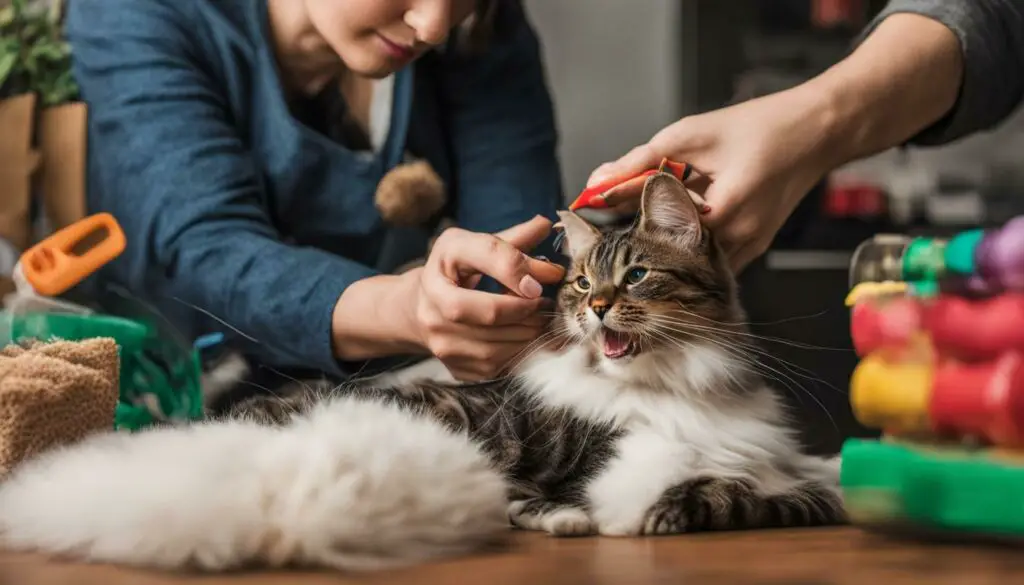
Conclusion
Properly trimming your cat’s nails is an important aspect of their overall well-being. By mastering the correct techniques and following professional cat nail trimming tips, you can ensure a safe and stress-free experience for both you and your feline friend. Remember to approach the process with patience, use appropriate equipment, and reward your cat’s cooperation. With time and practice, nail trimming can become a routine task that strengthens the bond between you and your beloved pet.
Strategies for Handling a Resistant Cat
If your cat refuses to cooperate during nail trimming, there are strategies you can try to make the process smoother. Cats can be sensitive about having their paws touched, but with patience and the right techniques, you can help them feel more comfortable. One approach is to enlist some backup assistance. Ask a family member or friend to gently hold your cat while you trim their nails. This can help keep the cat stable and reduce their anxiety.
Another effective method is to create a sense of security for your cat during nail trimming sessions. This can be achieved by using the “kitty burrito” technique. Wrap your cat snugly in a towel, leaving only their paw exposed. The enclosed feeling can help calm your cat and make them feel safe.
If your cat is extremely resistant to having their nails trimmed, you can try a staggered approach. Trim one or two nails at a time, rewarding your cat with treats and praise after each successful trimming. This gradual process can help build trust and make nail trimming less stressful for both you and your cat.
Expert Tip:
“When handling a resistant cat, it’s important to remain calm and patient. Never force the cat or punish them during the nail trimming process. This will only exacerbate their fear and resistance. Remember, it may take time for your cat to become comfortable with nail trimming, so be gentle and understanding throughout the process.”
By implementing these strategies and remaining consistent in your approach, you can help your cat become more accepting of nail trimming. Remember, it is important to be cautious and gentle when handling a resistant cat. If you are unsure or uncomfortable with the process, it’s always best to seek the assistance of a professional groomer or veterinarian who has experience in handling difficult cats.
| Strategies for Handling a Resistant Cat | |
|---|---|
| 1. | Enlist backup assistance to hold the cat securely. |
| 2. | Try the “kitty burrito” technique by wrapping your cat in a towel to create a sense of security. |
| 3. | Take a staggered approach by trimming one or two nails at a time. |
Remember to always prioritize your cat’s well-being and comfort during nail trimming. With time, patience, and the right strategies, you can help your resistant cat develop a positive association with this essential grooming task.

Seeking Professional Help for Nail Trimming: Expert Tips and Advice
If all else fails, seeking professional help for nail trimming can be a great option to ensure your cat’s nails are properly maintained. Professional groomers and veterinarians have experience in handling difficult cats and can provide expert advice and techniques to make the process as stress-free as possible.
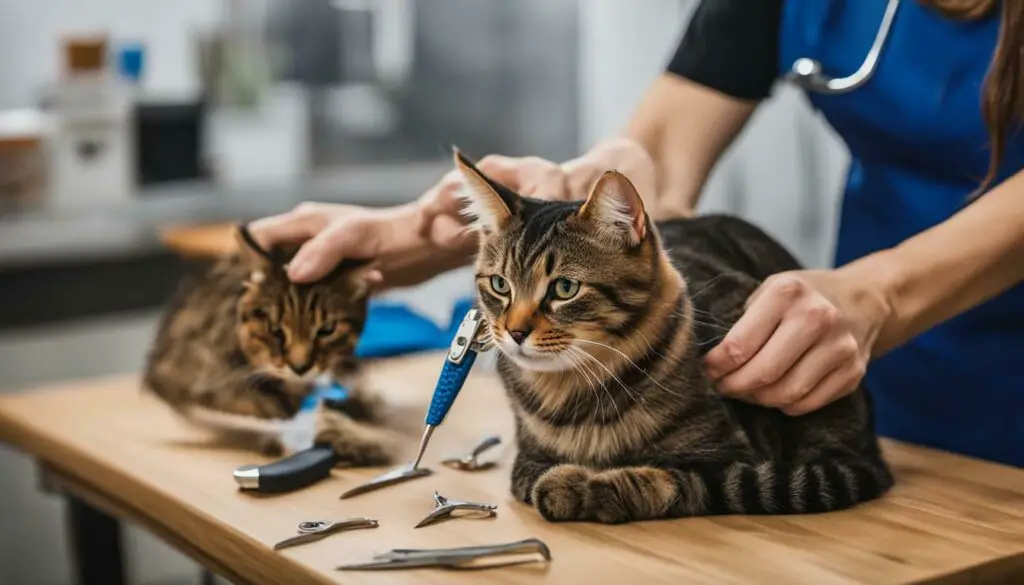
When choosing a professional to trim your cat’s nails, it is important to find someone who is knowledgeable and experienced in cat grooming. Look for professionals who have positive reviews and recommendations from other cat owners. Schedule a consultation or ask for a recommendation from your veterinarian to find a trusted professional in your area.
During the nail trimming session, the professional will use their expertise to safely and effectively trim your cat’s nails. They will have professional-grade tools and may also offer additional services such as nail filing or applying soft nail caps. Some professionals may even offer sedation options for extremely resistant cats to ensure the process is as comfortable as possible.
Benefits of Professional Help
- Expertise: Professionals have the knowledge and experience to handle challenging nail trimming situations.
- Safe and precise trimming: Professionals know how to trim a cat’s nails without causing injury or discomfort.
- Additional services: Some professionals offer nail filing or application of soft nail caps to further protect your furniture and carpets.
- Sedation options: For extremely resistant cats, professionals may offer sedation options to ensure a stress-free experience.
While seeking professional help may come at a cost, it can be a worthwhile investment in your cat’s health and well-being. Remember, regular nail trimming is an essential part of responsible cat care, and by seeking professional assistance when needed, you can ensure your cat’s nails are properly maintained.
The Dangers of Declawing
It is crucial to understand the dangers of declawing and explore alternative solutions for managing your cat’s claws. Declawing, also known as onychectomy, is a surgical procedure that involves the amputation of the last bone of each toe, including the claw. While it may seem like a convenient solution to prevent scratching, declawing is extremely harmful and can have serious consequences for your cat’s physical and psychological well-being.
Declawing is a painful procedure that can cause significant discomfort and potential complications. Cats rely on their claws for various activities, such as balance, climbing, and self-defense. Removing their claws not only deprives them of their natural behaviors but also alters their anatomy and can lead to long-term pain and discomfort. Declawed cats may experience chronic pain, lameness, and difficulty walking or jumping. They may also develop behavioral issues, such as aggression or litter box aversion, as a result of the physical and emotional trauma associated with declawing.
Declawing is a painful procedure that can cause significant discomfort and potential complications.
Instead of declawing, there are alternative solutions available to manage your cat’s claws. Regular nail trimming is an essential part of cat care and can help prevent scratching-related issues. By trimming your cat’s nails regularly, you can maintain them at a manageable length and reduce the risk of injury. Additionally, providing appropriate scratching surfaces, such as scratching posts or boards, can redirect your cat’s natural scratching behavior away from furniture and carpets. Cats can also benefit from nail caps, which are soft covers that can be applied to their nails to prevent them from causing damage.
By understanding the dangers of declawing and exploring humane alternatives, you can ensure the well-being of your cat and create a harmonious living environment. Remember, responsible cat care involves providing appropriate outlets for your cat’s natural behaviors rather than resorting to painful and unnecessary procedures.
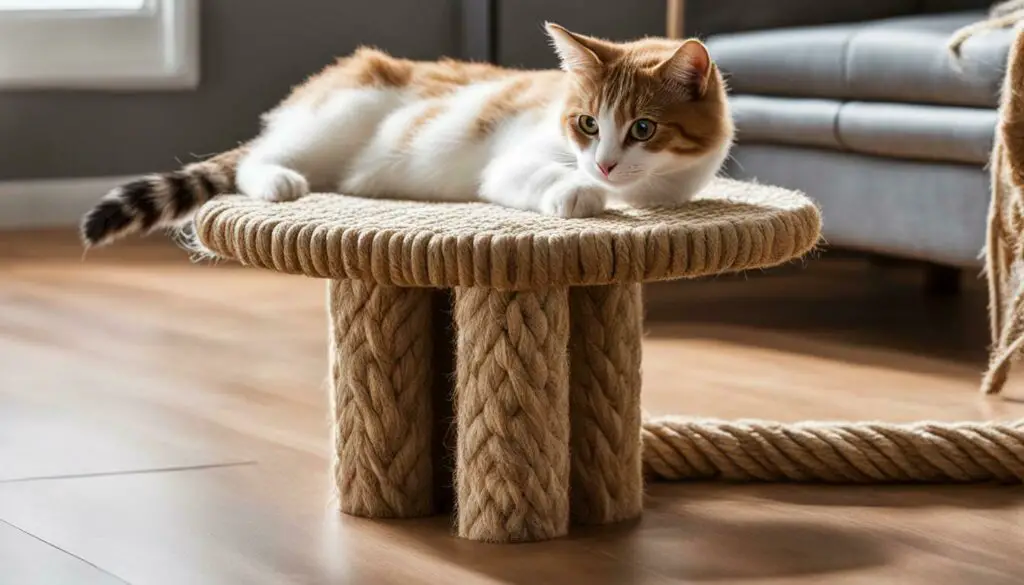
Maintaining Consistent Nail Care
Consistency is key when it comes to maintaining your cat’s nail health and preventing any potential issues. Regular nail trimming helps keep your cat comfortable and avoids problems such as ingrown nails or scratches on furniture and carpets. To ensure the best care for your furry friend, here are some essential tips and cat grooming hacks to help you maintain consistent nail care at home.
1. Establish a grooming routine: Set a specific day and time each week for nail trimming. This routine will help your cat become familiar with the process and make them feel more at ease. Choose a quiet and comfortable location where you can easily access your cat’s paws.
2. Use positive reinforcement: To make the nail trimming experience positive, reward your cat with treats, praise, or playtime after each successful trimming session. Positive reinforcement will help your cat associate nail care with positive experiences and reduce any resistance.
| Grooming Supplies | Description |
|---|---|
| Cat nail trimmers | Choose a pair of cat nail trimmers that are suitable for your cat’s size and nail thickness. Opt for trimmers with sharp blades to ensure a clean cut. |
| Nail file or grinder | Using a Nail file or grinder can help smooth out any rough edges after trimming your cat’s nails. This step is especially important if your cat has a tendency to scratch surfaces. |
| Treats or rewards | Having treats or rewards on hand can help distract and reward your cat during the grooming process. It’s a great way to reinforce positive behavior. |
| Towel or blanket | Using a towel or blanket to wrap your cat can provide a sense of security and make them feel more relaxed during nail trimming. |
3. Create a calm environment: Cats are sensitive to their surroundings, so it’s important to create a calm and stress-free environment during nail trimming. Play soft music, use dim lighting, and ensure you are in a calm state of mind. Communicate with your cat in a soothing voice to help them relax.
By following these tips and maintaining consistent nail care, you can ensure your cat’s nails stay healthy and comfortable while strengthening the bond between you and your furry companion.
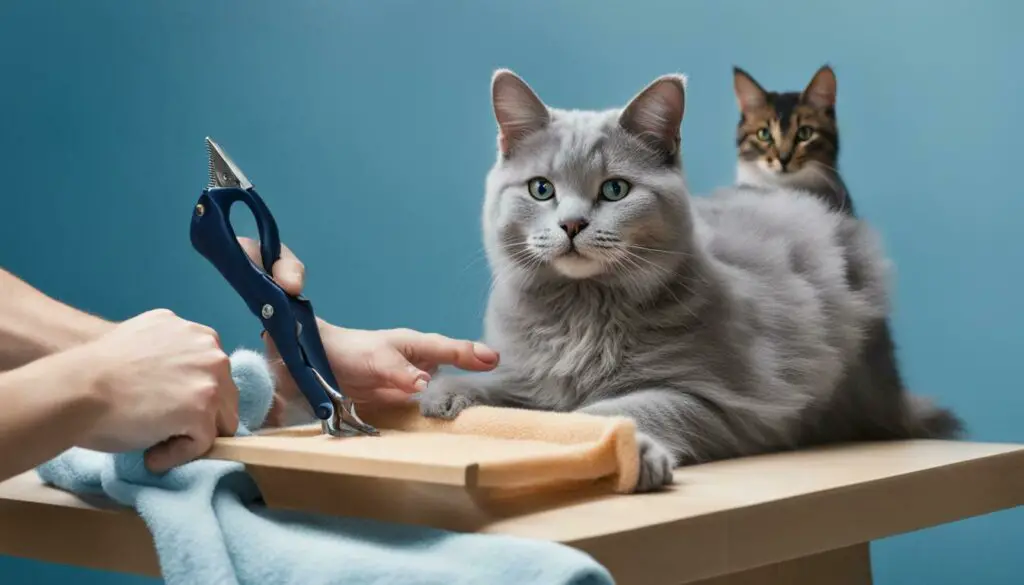
Understanding the Benefits of Nail Trimming
Nail trimming offers numerous benefits to your cat’s health and overall happiness. Cats’ nails grow quickly, and if left untrimmed, they can become long and sharp, leading to various issues. Regular nail trimming helps prevent the nails from becoming too long and curling back into the paw pads, which can cause pain and discomfort. It also reduces the risk of the nails breaking or splitting, which can be painful for your feline friend.
In addition to preventing physical discomfort, regular nail trimming can also protect your furniture, carpets, and other household items. Cats naturally scratch to mark their territory and stretch their muscles, and sharp nails can cause damage to upholstery, carpets, and even walls. By keeping your cat’s nails trimmed, you can significantly reduce the chances of them scratching and causing costly damage to your home.
Nail trimming sessions also provide an opportunity for you to spend quality time with your cat and strengthen the bond between you. It allows you to groom and care for your cat, showing them love and attention. By creating a positive and calm environment during nail trimming sessions, you can help your cat associate the experience with a pleasant time spent together.
| Benefits of Nail Trimming: |
|---|
| Physical Comfort: Prevents nails from becoming too long, curling into paw pads, or breaking. |
| Protects Your Home: Reduces the risk of furniture and carpet damage caused by sharp nails. |
| Bonding Opportunity: Allows you to spend quality time with your cat and strengthen your bond. |
Regular nail trimming not only benefits your cat’s physical health but also helps prevent damage to your home. It’s a win-win situation!” – Jane, Cat Owner
Remember to approach nail trimming with patience and care. If you’re unsure about how to trim your cat’s nails or if your cat is resistant, it’s always best to seek guidance from a professional groomer or your veterinarian. They can provide expert advice and demonstrate proper techniques to ensure a safe and stress-free experience for both you and your furry companion.
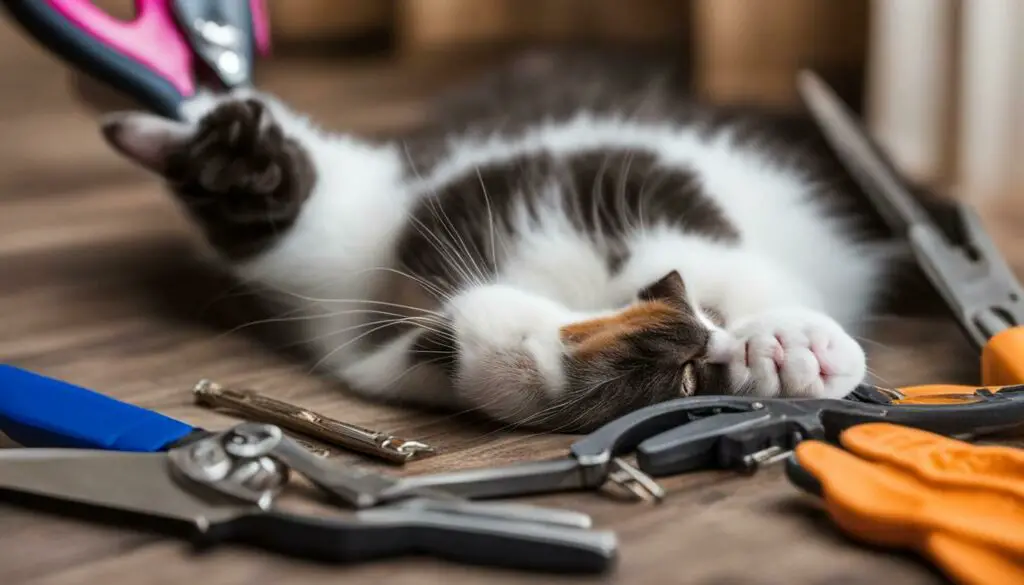
Conclusion
Taking care of your cat’s nails doesn’t have to be a stressful task, and with the right approach, you can successfully maintain their nail health. Regular nail trimming is essential for your cat’s well-being and to prevent damage to furniture and carpets. Cats’ nails can grow quickly, and if left untrimmed, they can puncture the pads of their paws, leading to pain and potential infection.
One of the main reasons cats resist nail trimming is because they dislike having their paws touched. Starting the nail trimming process when your cat is young and gradually getting them used to having their paws handled can make the process easier for both of you. It’s also important to use the correct equipment, such as cat nail trimmers, to ensure a safe and precise trim.
When a cat is resistant to nail trimming, there are strategies you can try. Enlisting help from another person to hold the cat securely can make the process more manageable. Wrapping the cat in a towel to create a “kitty burrito” can also provide a sense of security. If your cat is extremely resistant, you can try trimming one or two nails at a time, taking a staggered approach.
If you’ve tried everything and your cat still won’t let you trim their nails, it may be worth seeking professional help from a vet or groomer who has experience in handling difficult cats. They can safely trim your cat’s nails for a fee. It’s important to note that declawing should never be attempted, as it is a harmful procedure with potential physical and psychological consequences for your cat.
Overall, keeping your cat’s nails trimmed is an essential part of responsible cat care. Regular nail trimming helps prevent discomfort, injuries, and damage to your home. By following the expert advice and tips provided in this article, you can successfully trim your cat’s nails and maintain their health and well-being.
FAQ
How often should I trim my cat’s nails?
It is recommended to trim your cat’s nails every 2-4 weeks, depending on their growth rate and activity level.
How do I prevent cutting the quick while trimming my cat’s nails?
Be cautious and trim only the tip of the nail, avoiding the pink area called the quick where the blood vessels and nerves are located. If unsure, it is best to consult a veterinarian or professional groomer for assistance.
What if my cat is resistant to having its nails trimmed?
If your cat is resistant, try using distractions, getting some help to hold the cat securely, or employing the “kitty burrito” technique of wrapping them in a towel. You can also try trimming one or two nails at a time.
Can I declaw my cat instead of trimming its nails?
No, declawing is a harmful and inhumane procedure that should never be attempted. There are alternative options available to manage a cat’s claws without resorting to declawing.
Can I trim my cat’s nails myself or should I seek professional help?
You can trim your cat’s nails at home if you feel confident and have the necessary equipment. However, if your cat is extremely resistant or you’re unsure about the process, it is advisable to seek professional help from a veterinarian or groomer.
Are there any tips for making the nail trimming process easier?
Yes, starting the nail trimming process when your cat is young, getting them used to having their paws handled, and using positive reinforcement techniques can help make the process easier and less stressful for both you and your cat.
Source Links
- https://cats.com/cat-wont-let-me-trim-nails
- https://consciouscat.net/trim-you-cats-nails-the-right-way-and-nobody-gets-hurt/
- https://www.usatoday.com/story/news/2023/02/19/how-to-trim-cat-nails/11024346002/

